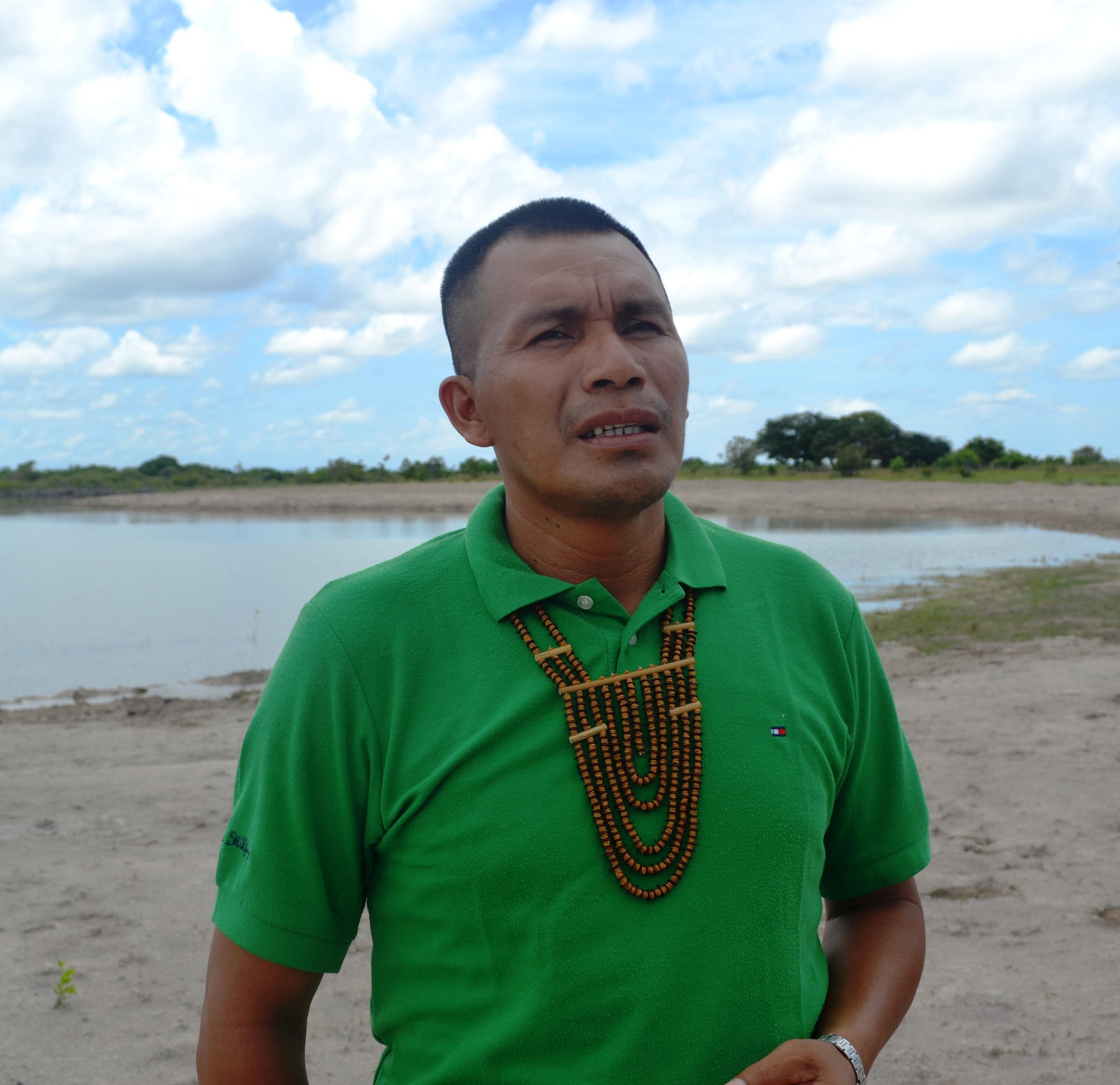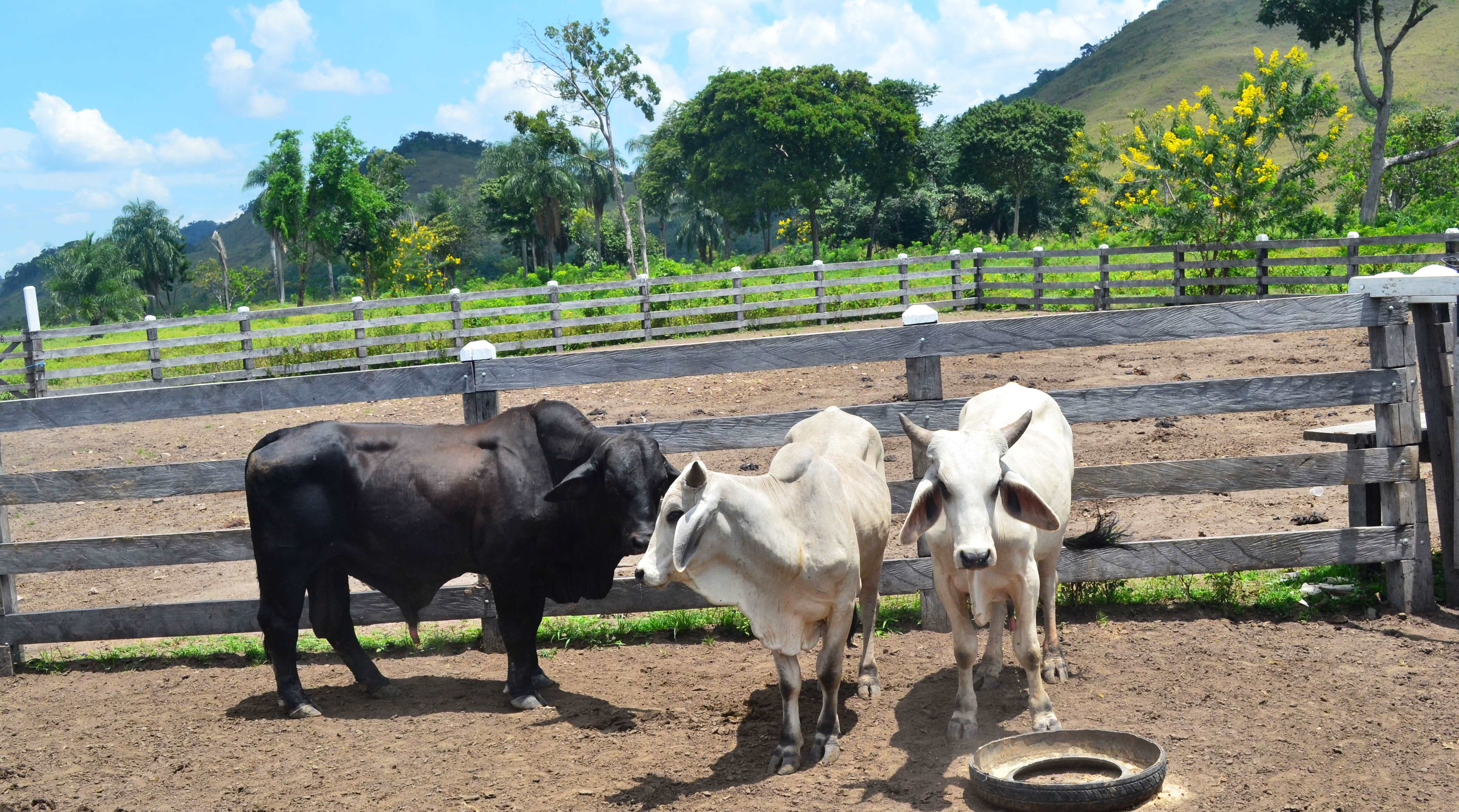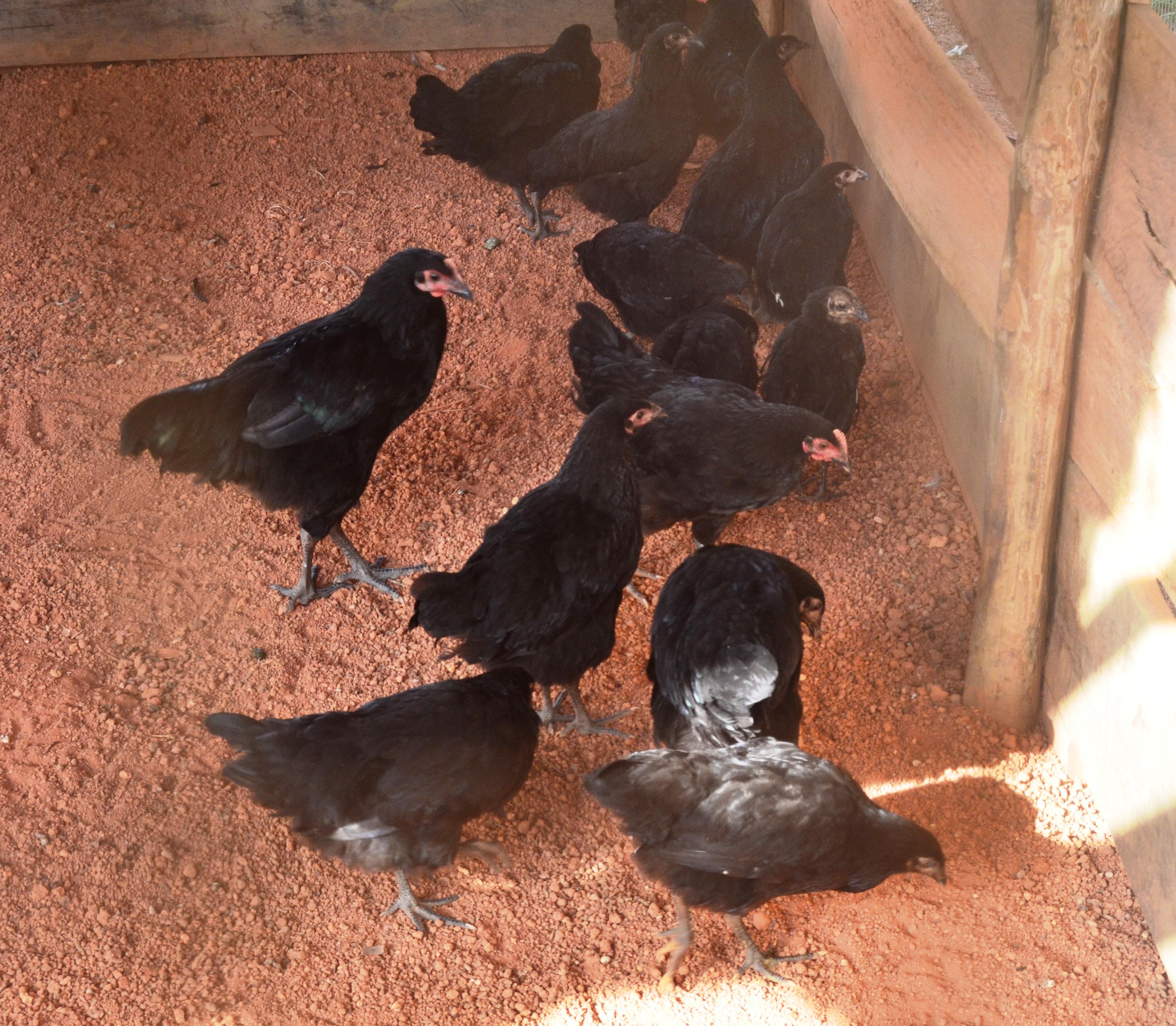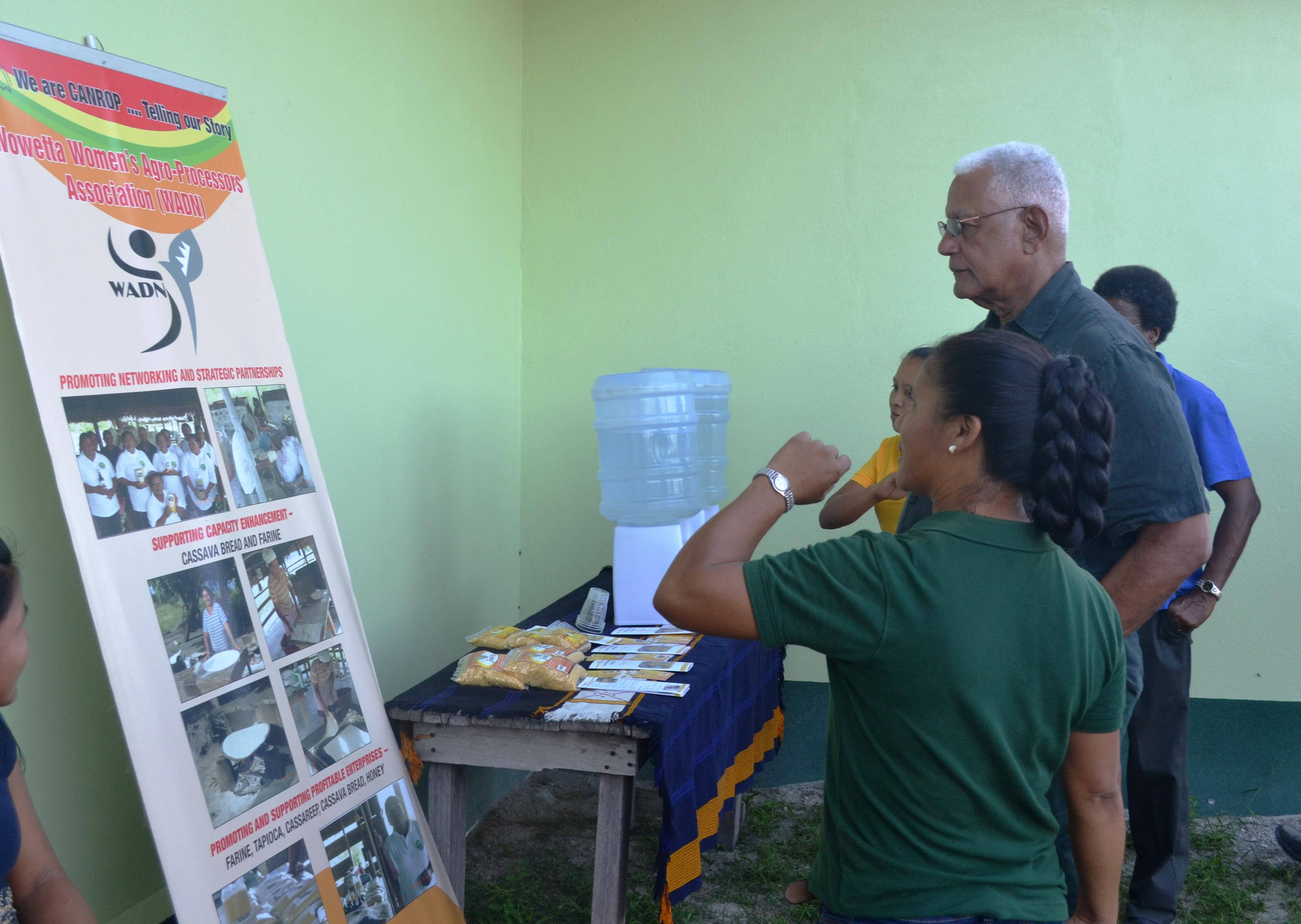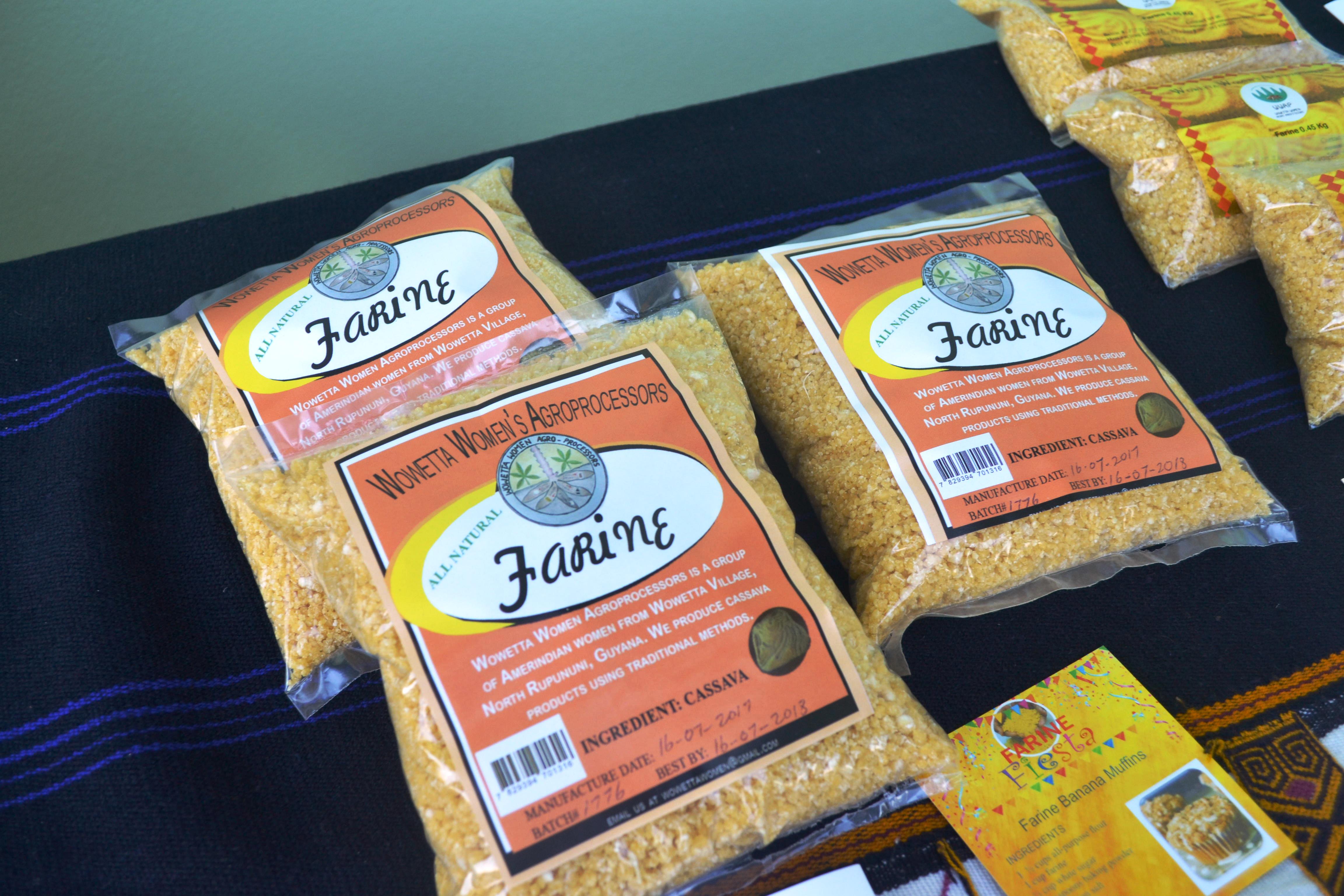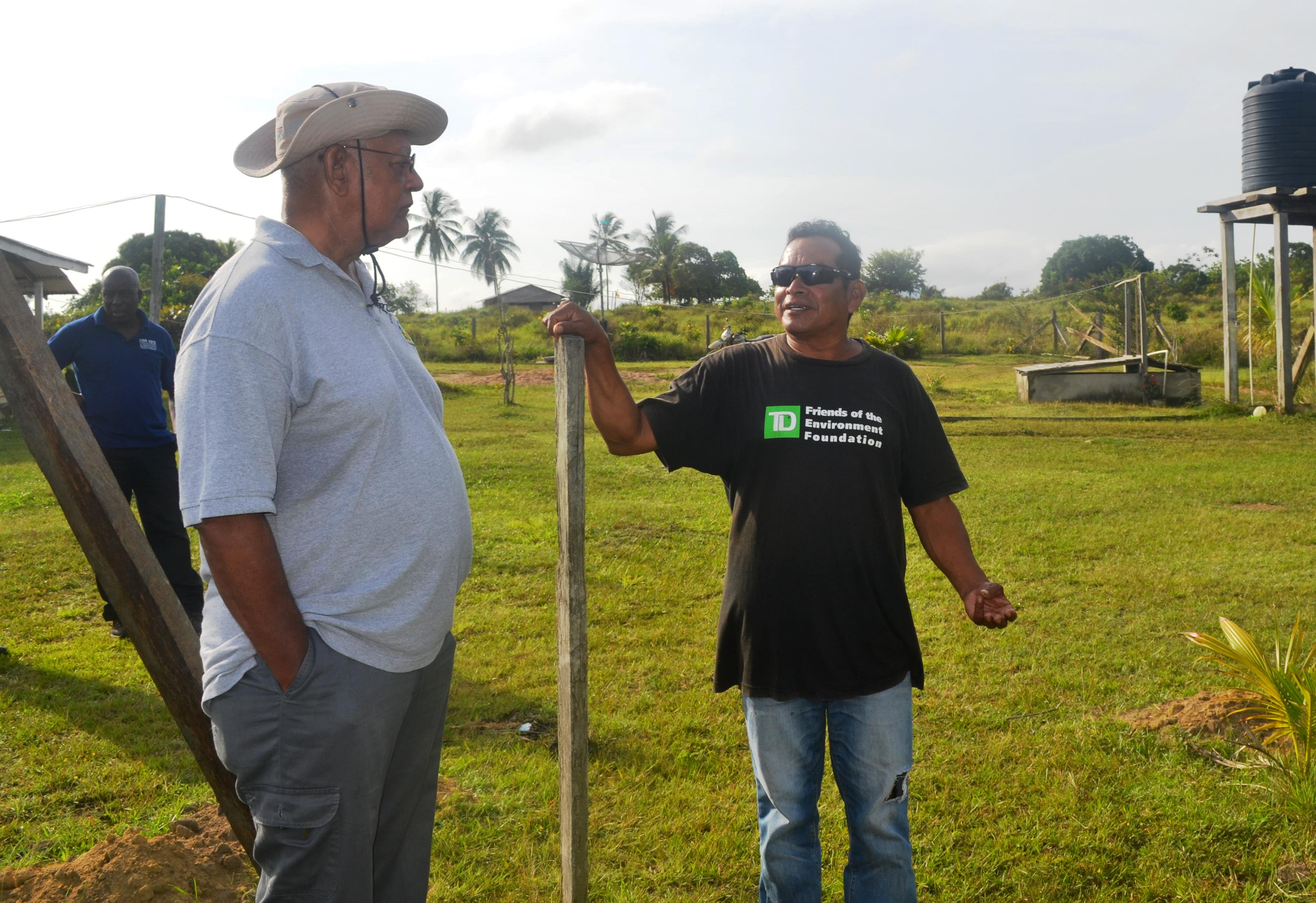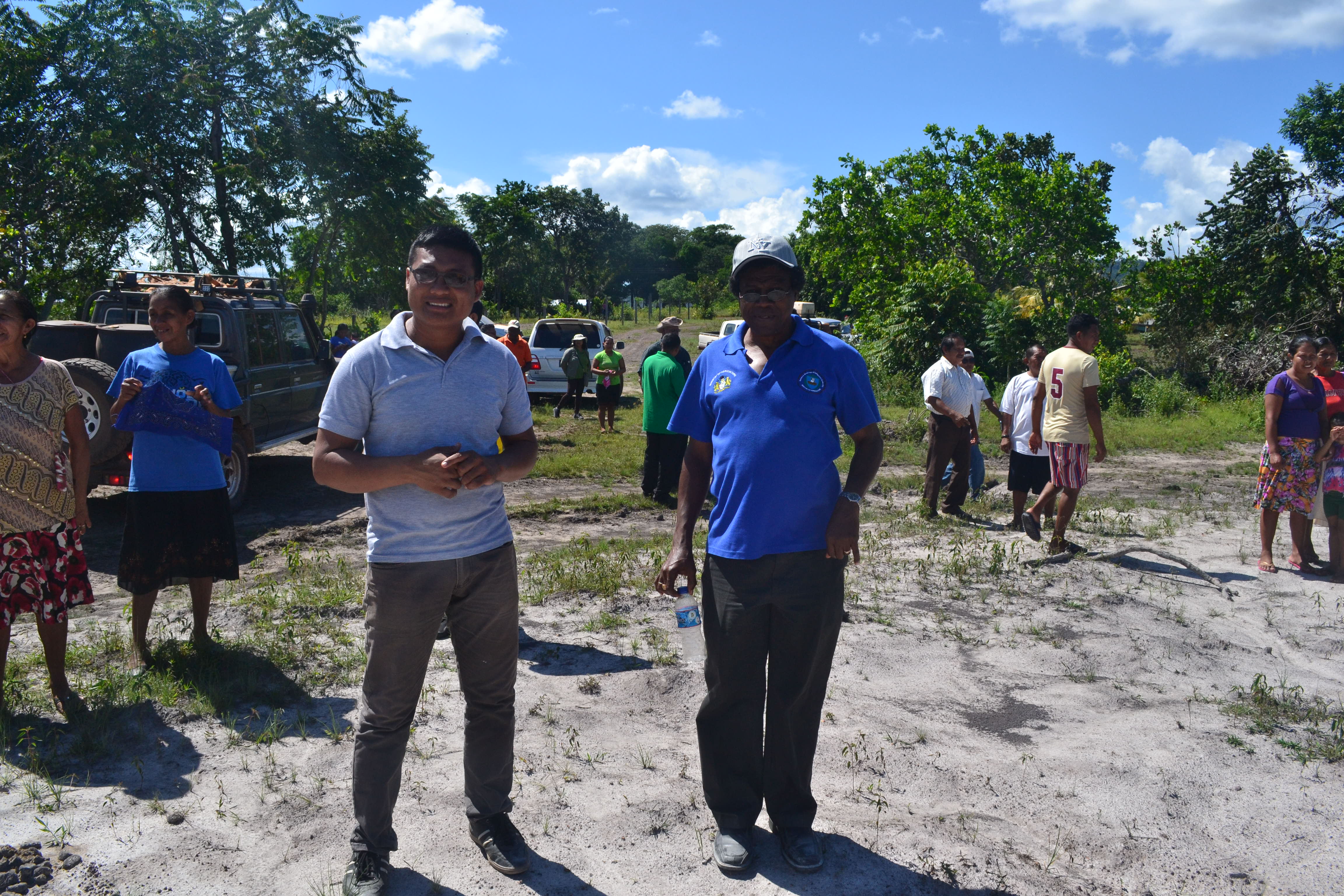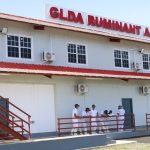With government making positive strides to move Guyana’s agriculture base inland, Agriculture Minister, Noel Holder concluded a three-day outreach to the Rupununi where he visited a number of communities and villages to advise the region on issues faced in agriculture and what the Agriculture Ministry, and by extension Government, has planned to boost agricultural development in the region.
During the outreach, Minister Holder met with a number of regional representatives, Toshaos and residents to discuss the works already being undertaken, planned projects and other initiatives that the ministry has outlined for the region.
Some of the projects that have commenced are the construction of water catchment structures, poultry and livestock development initiatives as well as crop development and marketing. The Ministry is also set to construct an agricultural station at Pirara which will involve demonstration plots, herds of cattle, poultry rearing, orchards and seed stock.
The Pirara Research station will also boast a huge water catchment area that will provide irrigation all year round.
Water Catchment in the Rupununi
With the Intermediate and Rupununi Savannahs historically experiencing extended dry seasons which result in drought like conditions, the Ministry of Agriculture has embarked on constructing a number of water catchment reservoirs across the Region. The project, which is being undertaken by the National Drainage and Irrigation Authority (NDIA) under the directive of the subject minister, will entail the construction of reservoirs across both North and South Rupununi.
During the outreach, Minister Holder visited catchment structures that have been strategically constructed in Nappi, Masara, Aranaputa, Bina Hill, and Annai to assess the state of the projects. Expressing satisfaction at the progress made thus far, Minister Holder indicated that the reservoirs are essential for sustainable agriculture to be practiced in the region.
“Because of the worsening effects of climate change, which have resulted in extreme temperatures, water resources are becoming limited. With this in mind, the ministry has commenced the construction of several reservoirs in the region. With the construction of these reservoirs, residents will be able to practice sustainable agriculture even during the extensive dry season. Usually, agriculture would be difficult to practice during this period as water availability becomes extremely limited. These catchment areas are being constructed strategically to function as a source of water for livestock, crops and aquaculture.” Minister Holder said.
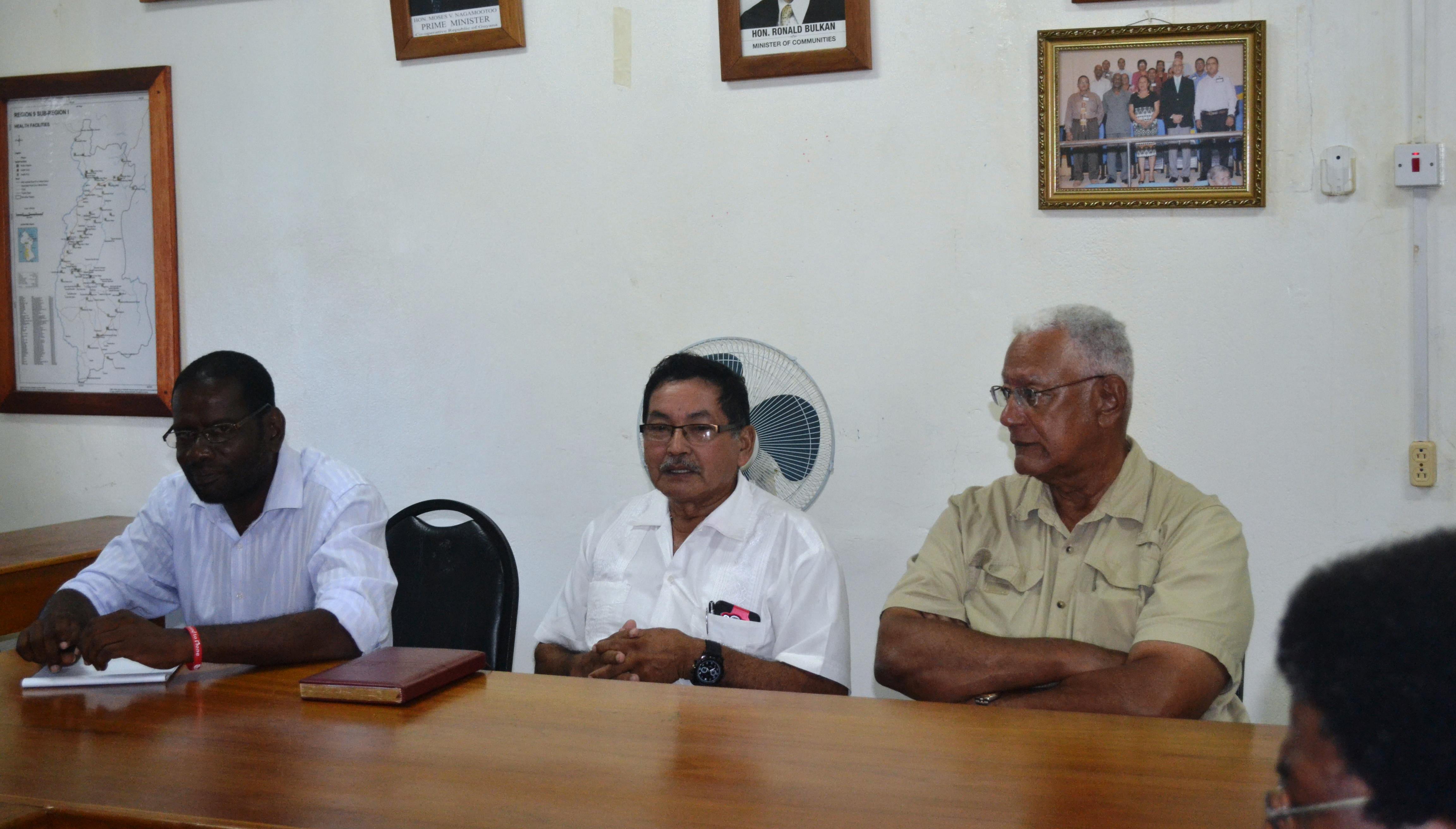
From left- Regon 9 REO Kerwin Ward, Regional Chariman Bryan Allicock and Agriculture Minister, Noel Holder during the meeting
While meeting with the Regional Chairman and several Regional Councillors of the Region 9 RDC, Minister Holder, however pointed out that it will be equally important for the relevant authorities to enforce land management around these reservoirs or irresponsible occupancy around the structures may occur. This, he added, will be the responsibility of the Regional Council as they will be in charge of ensuring the residents utilize the water resources responsibly as the maintenance of protocols will be very important. The regional council, the minister added, needs to meet with all residents to establish operational protocols for these catchment areas.
Acknowledging the role of the council and other regional authorities, Regional Chairman of Region Nine, Mr. Bryan Allicock, assured that management control systems have commenced as it relates to areas around these catchment areas.
“We have commenced development systems on how to control and manage these areas around the catchment structures. We will be establishing buffer zones where certain activities like squatting and the construction of housing and other permanent structures are prohibited. I understand our role in regional development and our plan of action for that looks at what central government as well as the regional administration are doing and we integrate those measures into our plan.” Mr. Allicock said.
Resident NDIA Engineer, Abraham Realine indicated that the Reservoirs will be used for a host of agricultural purposes.
“When we commenced construction of these catchment structures, the initial plan was for them to service crops and cattle during the dry periods. However, plans to introduce aquaculture has been expressed by the residents of the various communities in which the excavation of the catchment areas were executed. Indigenous species of fish are expected to be added to some of the ponds.” Mr. Realine said.
Conservation International’s Technical Coordinator in the Region, Mr. Rene Edwards indicated that his organization is committed to working with the ministry to ensure the region realises development in a sustainable way.
“We understand the need for development, so we have partnered with the community and the Ministry of Agriculture to ensure that all the initiatives take into account the need to preserve the environment and its natural flora and fauna.” Edwards said.
Minister Holder reiterated that such initiatives will allow development at different levels and this project is just a start to the major plans his ministry has for the region.
“We want to replicate this system of water catchment across the savannahs so that we would encourage much better land usage. With water harvesting we would have a water storage system to provide irrigation and persons would be able to access water for agriculture. Appropriate methods of irrigation will have to be decided – perhaps drip irrigation or other case specific methods will have to be determined.” Minister Holder said.
Expressing their satisfaction on behalf of their communities were the Toshaos of Masara, Mr. Leon Moses, Mr. Mark George of Annai, and Chairman of the Aranaputa Community Mr Aiden Jacobus.
At Masara, toshao Moses said the establishment of the reservoirs has opened up a whole new range of exciting possibilities for the community of just over 400 persons. “Our community earns its income from the environment. Fishing is a lucrative business for the fishermen who sell their catch to neighbouring villages and people who visit. Cash crop farming is another income generator but for many months of the year, this is a lost cause as no water is available for irrigation.:” the Toshao added that he is now excited that the rearing of cattle and the establishment of grass pastures are now possible through the establishment of the catchment areas.
Chairman of the Pakaraima Valley Community of Aranaputa, Mr, Aden Jacobus was loud in his praise of the support his community, of just over 600 residents, has received from the Ministry of Agriculture. This, he said, has come in many forms – with the establishment of huge catchment area being the latest intervention.
“Our community is heavily into beef production, and with a year round supply of water we can now establish pastures and grow our herds. Our youths are very interested in getting involved in agriculture and with the incentives and assistance being provided directly by Government and indirectly through the Ministry of Indigenous People’s Affairs and the Ministry of Agriculture, the future looks very bright for them.” Jacobus added.
Across at Annai, Toshao Mark George was also confident that the establishment of the catchment areas in his community as well others across the region was the catalyst needed to jump start agricultural pursuits in the region. He looks forward to the continued support of the ministry of Agriculture in the provision of technical guidance as the community sets out on its journey to prosperity through agriculture.
Resuscitating Guyana’s Livestock Industry
Guyana remains free of a number of diseases like foot and mouth disease that negatively affected the cattle industry. As such, the Ministry of Agriculture is making several steps to resuscitate the cattle industry. Given the massive amounts of land available, the Rupununi and Intermediate Savannahs are expected to be key players for this to be achieved. Steps are being taken to rebuild Guyana’s beef and dairy herds and to take advantage of the large international market for ‘Grass Fed’ beef.
Minister Holder met with members of the Region Nine Livestock Committee and explained plans to resuscitate the cattle industry.
“In the past, the Rupununi was the cattle capitol of Guyana. We plan to get the country’s cattle industry going and we acknowledge the role this region will play in that plan. Initial steps have been taken to get the ball rolling with funding for several projects being acquired through loans granted by the Inter-American Development Bank (IDB).” Minister Holder said.
Chairman of the Region Nine Livestock Committee, Kenneth Forde commended the Minister for his ministry’s input into cattle development for the region thus far, while highlighting some of the steps the region taken to aid the cause.
“At the community level we are trying increase the herd in the region. Our first step was the acquisition of breeding bulls. The Guyana Livestock Development Authority has played a major role in assisting us with our plans. We have regular visits from officers who give technical advice where necessary. However, we are seeking technological development in this regard.”
Project Coordinator for the Sustainable Agricultural Development Program, Mr. Khemlall Alvin indicated that the project entails three aspects that will have a tremendous impact on the region.
“The Sustainable Development Agricultural Development Program, which is being funded by the IDB, will see the Agriculture Sector Development Unit (ASDU) of the Ministry facilitating three major projects that will have a great impact on the region. There will be a country wide agriculture census to document the number of cattle, crops, aquaculture, etc. in the country. With this data in hand, government will be able to better strategize when it comes to what is needed to boost agriculture in Guyana. Additionally, the project involves the construction of catchment areas around the region and the construction of an abattoir. The abattoir will be built in accordance with European design and standards.” Mr. Alvin said.
Minister Holder pointed out that Guyana not having an abattoir that is of international standards has hampered the industry and acquiring such a facility has always been on the front burner as it relates to resuscitating the industry.
‘Black Giant’ project to augment Rupununi Poultry
Earlier this year, the Guyana Livestock Development Authority (GLDA) officially launched its Hinterland Development Black Giant Poultry Programme which saw the handing over of one hundred (100) Black Giant chickens along with the requisite start-up feed and other supplies to hinterland schools and groups, coastal schools and organisations representing the first phase of the project.
In region 9, black giant chickens were given to the Bina Hill technical institute for research and development, where the students are involved in the care and management of the birds. Since receiving the birds and chickens, they have grown considerable and have started laying. The black giant project was also extended to residents of Surama.
During his three day outreach to across region 9, Minister Holder visited the Bina Hill Institute and interacted with the administrators of the project as well as the students there. He also visited several persons in Surama Village who benefited from the program, and got a first-hand look at their successes at maintaining and further increasing their flock. He indicated that the main objective of the initiative was to assist in making the hinterland regions less reliant on the Coast for their food supplies.
“We know the struggle and the cost of having to access food supplies from the Coast. With the introduction of this program, the regions is expected to become self-sufficient as it relates to poultry. The Black Giant is a large dual purpose chicken, which has the ability to produce up to 200 eggs annually and about 4.5 kilograms of meat. These birds have the ability to graze and forage as well as eating leftovers from the kitchen and still produce reasonably well. Given these qualities the Black Giant was seen well suited to hinterland region.” Minister Holder said.
Emily Allicock, one of the residents who benefited from the Black Giant Initiative indicated she has been able to see positive returns since acquiring the birds.
“The chickens are growing quickly. I already have some laying and I am receiving a lot of support from GLDA. From the beginning they were helpful with advising me on how to construct the pens and proper management and sanitation for the birds.” Ms. Allicock said.
Another poultry farmer, Mr. Trevor Thompson indicated that he is having successes in his current venture and has plans to acquire some of the Black Giants as he sees the successes other farmers are having with the birds.
Youth development and Agro-Processing
Minister Holder also visited the cassava processing facility at Wowetta where he was given a tour of the facility and an overview of its operations.
Wowetta Community Development Officer, Priscilla Torres indicated that the facility has been a major source of income for members of the Wowetta Women’s Agro-processing Association.
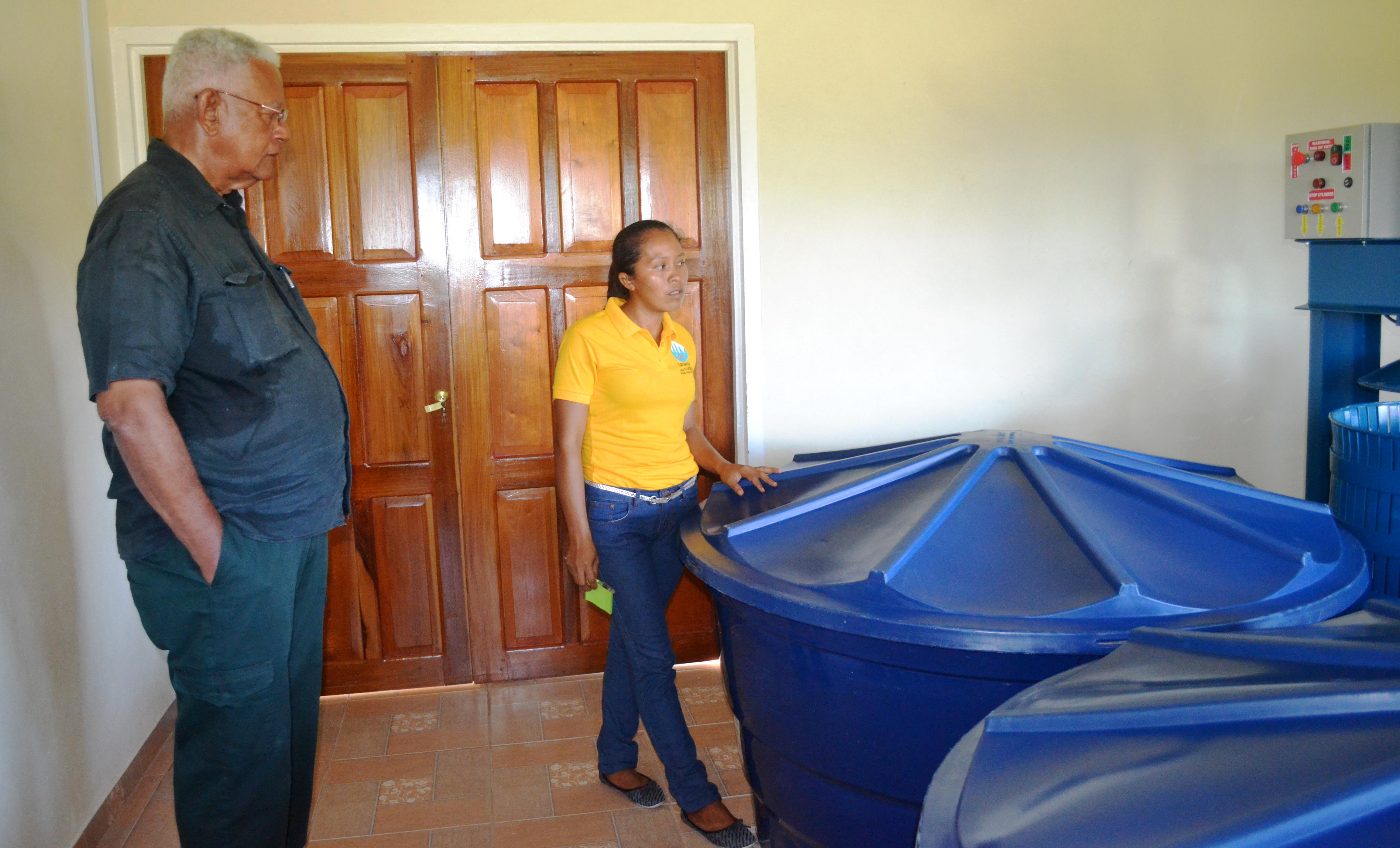
Minister Holder during a tour of the Cassava Processing Factory. He is pictured with Ms. Grace Albert, Operations Manager for the factory
“Even though the facility has not been commissioned it is functioning. We are doing well and the Guyana Marketing Corporation has been extremely helpful in assisting us with getting our products on the market. Currently, our main product is farine, because it is a part of the Region’s Disaster Preparedness Strategy. We also produce cassava bread. We are hoping to expand our facility so that we can produce other products like cassareep and cassava flour. However, there is a need for technical support such as testing our products to determine its suitability for international markets and better packaging material.” Ms. Torres said.
Minister Holder commended the group and committed to continued support through the New GMC in acquiring markets and seeking out the technical support that is needed to get the products on the international markets.
The Hinterland Employment Youth Service is a program that was designed to equip hinterland youths with skills in agriculture so that they can gain a career in agriculture. Earlier, during his visit to Aranaputa, Minister Holder spoke with a number of participants of the program and offered assistance through the ministry’s agencies in the form of technical advice and support in several areas.
Adon Jacobus, Chairman of Annai, indicated that the program has been playing a major role in preparing youths for a career in agriculture.
“Currently the program runs for 12 months and has 23 participants. Since its commencement in August, the participants have been working on several projects that are expected to assist them in the future. At the end of the program, the participants are expected to have developed a business plan and will be given some amount of funding to start their business.” Mr. Jackovis said.
Minister Holder was accompanied on his region 9 outreach by the CEO of NDIA, Mr. Fredrick Flatts, Chief Hydromet Officer, Dr. Garvin Cummings, Chief Fisheries Officer, Mr. Denzil Roberts, Director of the Agriculture Sector Development Unit (ASDU), Mr. George Jervis, Project Coordinator within the ASDU, Mr. Khemlall Alvin and other resident officers of the Guyana Livestock Authority and the NDIA.
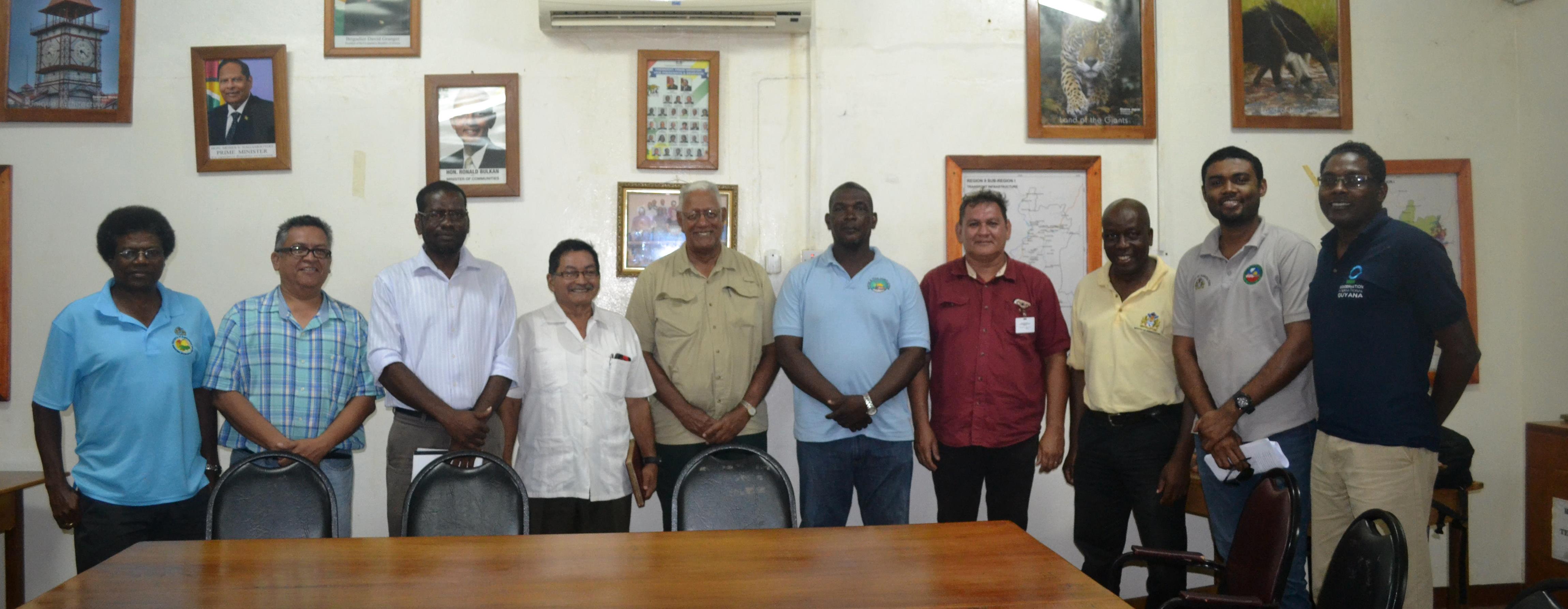
From left- NDIA CEO Fredrick Flatts, Chief Fisheries Officer Denzil Roberts, REO Kerwin Ward, Regional Chairman Bryan Allicock, Agriculture Minister Noel Holder, Region 9 Mayor, Carlton Beckles, Council Member Roger King, ASDU Director George Jervis, Chief Hydromet Officer Dr. Garvin Cummings and Conservation International – Guyana Representative Rene Edwards
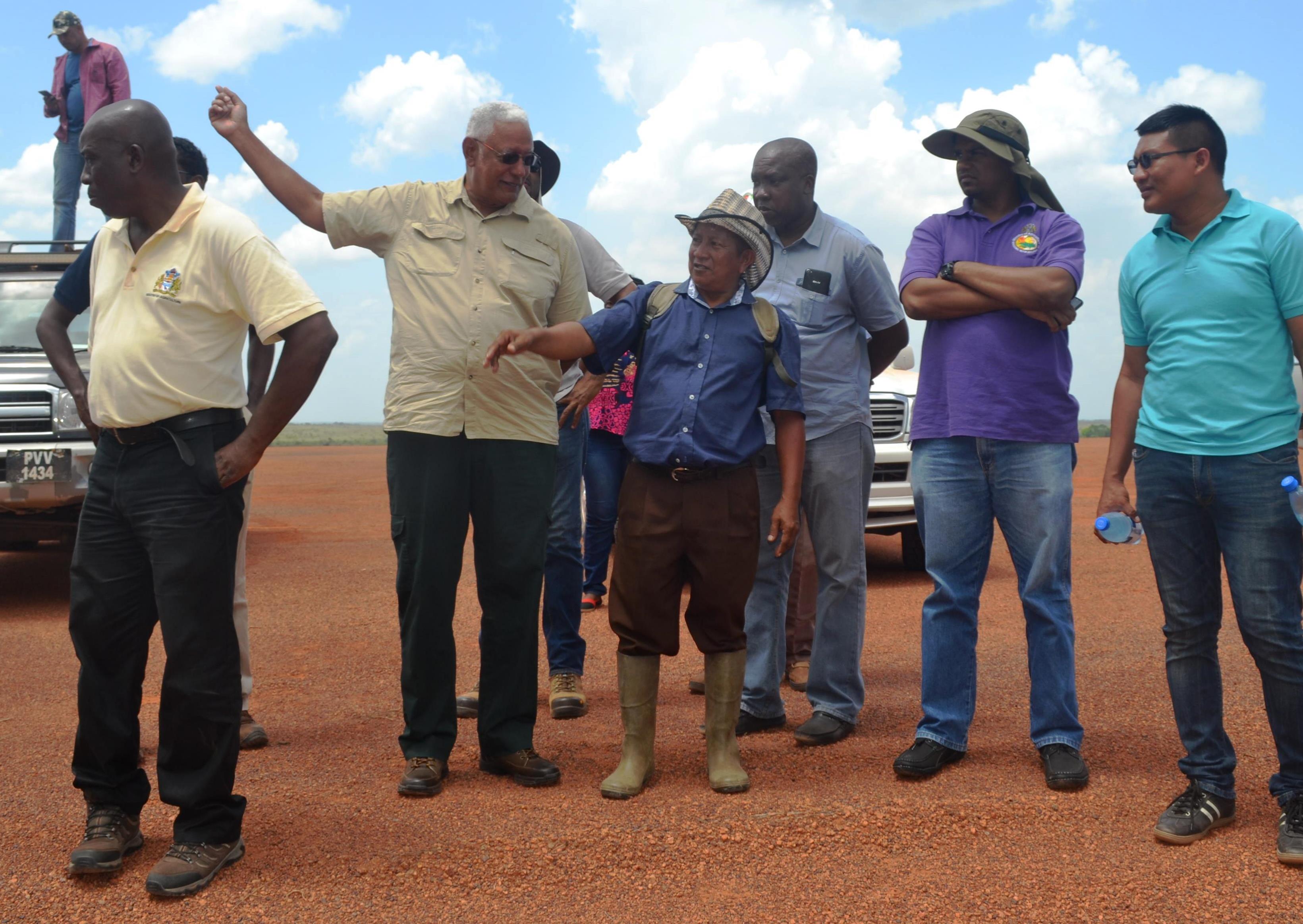
Minister Holder along with Nappi Village Toshao Walter Horatio along with other MOA representatives at one of the water catchment areas.


